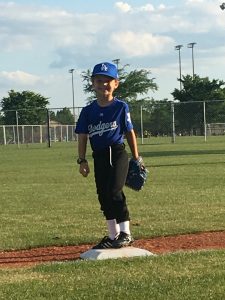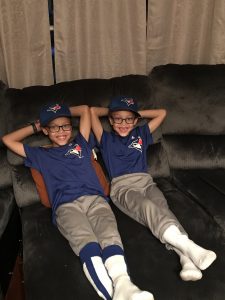 It was opening day for my boys.
It was opening day for my boys.
Not the majors, or even little league. Just recreational baseball through the city. But it was still opening day, and they were excited.
It had been more than a year since they had played any sports (due to one of the many pandemic-related choices we made), and they couldn’t wait to get back on the field.
When we got there, I felt my heart sink as I watched an all too familiar scene play out.
The Scene
We’re playing in a seven-to-nine-year-old division. Our team has quite a few seven year olds, and only a couple of nine year olds. The other team looked to be primarily nine year olds, as even its smallest player was bigger than our biggest.
None of the kids on our team have played together before. In fact, all but four have never played baseball before. The other team had played together for the past two years.
Our team is made up of only black and brown children. The other team was completely white.
 The first game of the season ended up being a rout. Our players still had great attitudes and enjoyed playing the game. But the new ones didn’t learn much, and the experienced players got a bit frustrated when there was no one to throw to and no one to help bring them home.
The first game of the season ended up being a rout. Our players still had great attitudes and enjoyed playing the game. But the new ones didn’t learn much, and the experienced players got a bit frustrated when there was no one to throw to and no one to help bring them home.
You could chalk this up to a one-off. There are always good teams and bad teams in a league.
But it’s not a one-off. We’ve played sports with the city of Arlington and the city of Fort Worth. We’ve played with three separate YMCAs.
And in each case, most of the teams were incredibly segregated, and the skill/experience levels of teams were worlds apart.
It’s not as simple as good teams and bad. Most important, in a recreational youth sports league, it shouldn’t happen.
Recreational sports are for fun, learning experiences. Yes, you want your team to win, but it’s more about playing and learning the game and having a good time while you do it.
So Why Does This Happen?
I would like to give the organizations we play with the benefit of the doubt and believe that they do not set up systems to segregate teams intentionally. Regardless of intention, that is exactly what happens.
When you sign up your child for a sport you are typically placed on a team in one of three ways: Where you live, coach request, or teammate request.
 On the surface, it seems logical. But here’s what happens in reality . . .
On the surface, it seems logical. But here’s what happens in reality . . .
If you have a coach or teammate request, that means you’ve played before. You have experience and some knowledge. A child who has never played before is at an automatic disadvantage by creating teams using these criteria.
Then, to add insult to injury, the rest of the kids are most often sorted by location.
Where you live seems a logical choice for geographically centralizing practices, but many neighborhoods are racially or socioeconomically segregated. Children from lower-income families are less likely to have sports experience, creating teams this way leads to a lack of diversity — both in culture and ability.
The Outcome
When you structure teams this way, all kids lose out, even the ones that win games.
When teams have vastly different skill levels, it’s significantly less fun for both sides. The best games to watch and play are ones with teams that are evenly matched.
If it’s not fun, kids aren’t going to play again. Feeling like you’re not good enough and you’ll never catch up is a hard thing to overcome when you’re young.
Without a wide range of play abilities on one team, kids with less experience miss out on the opportunity to learn from better teammates. When players with higher-level skills help their teammates learn, they improve in their own abilities, learn valuable life lessons about helping others and working together.
These situations don’t just affect the teams playing in preschool through elementary. It breeds issues as they grow up as well.
 Down the Road
Down the Road
When kids drop out instead of continuing to play, you end up with increasingly homogenous teams as children get older. A local school recently made news because a couple of players on their baseball team shared a racist meme targeting the only child of color on the team.
While many factors went into that situation, it’s easy to see how that happened and how a team made up of almost exclusively white kids came to be.
Being on a team with kids who look different, go to a different school, or live in a different neighborhood is eye-opening. Diversity in schools, in the workplace, in sports, is better for ALL people.
What Can We Do?
Parents have a lot of pull and when we speak up — through words, actions, and dollars — people listen.
Talk to the directors of your kids’ sports organizations. Find out the system and point out the flaws.
Choose one friend for your kiddo to play sports with instead of a whole team or a coach. Let your kids meet new people and have new experiences.
Check out the diversity of your local sports organizations. If it’s not diverse, try to change that or seek another option and let them know why you’re switching.
Support organizations such as Every Kid Sports. It works to level the playing field.
We have the power to change the system. Our choices can make a change and stop sports segregation














Emily, check out Westside Little League next season. Every kid gets a team but they have a draft so the coaches pick the kids.
Thanks Elizabeth!
I have heard about the drafts from a couple of people and while we really wanted to stay in less competitive leagues for the moment, I definitely see the merits of the draft concept and think it’s a much more equal way to split up teams, especially if they manage to keep it a low-pressure situation!
Do you happen to know how they work with siblings? Since the twins will obviously play in the same age group, it would be an issue if they ended up on separate teams that practice at the same time etc. Those #twinlife problems! 🙂